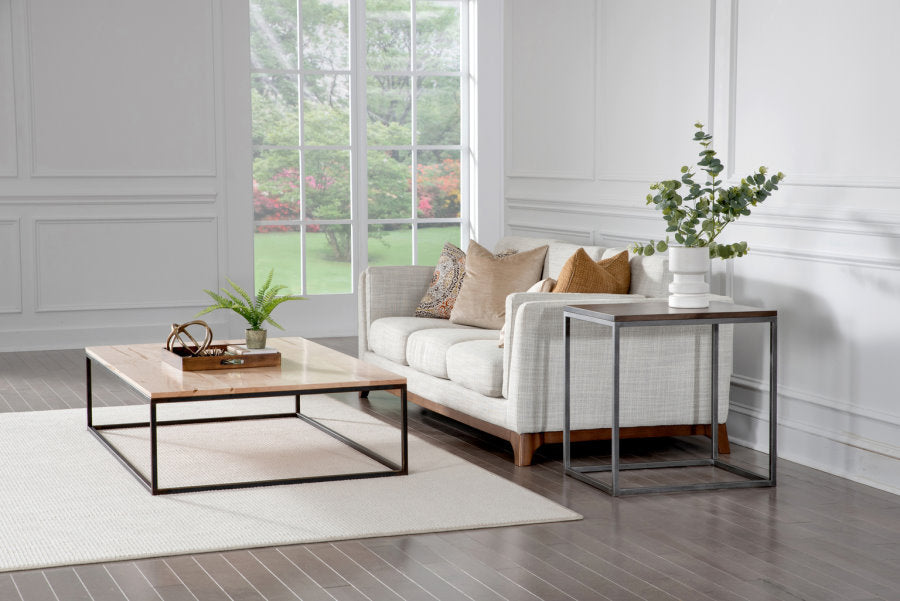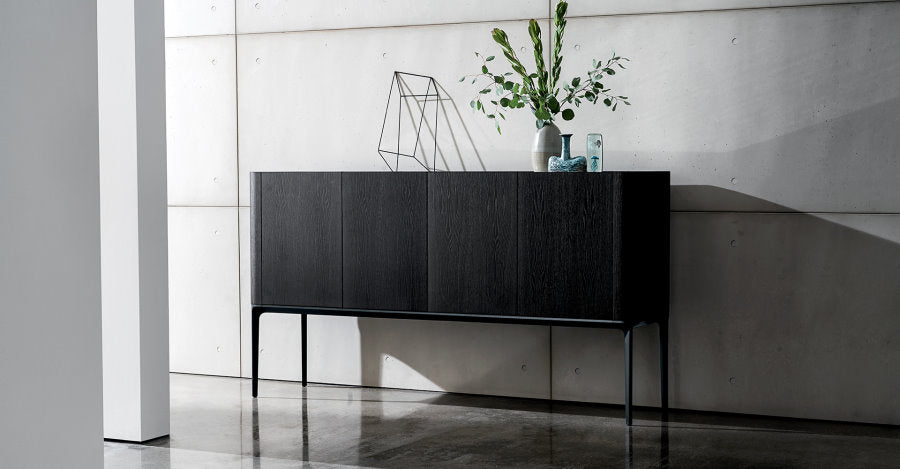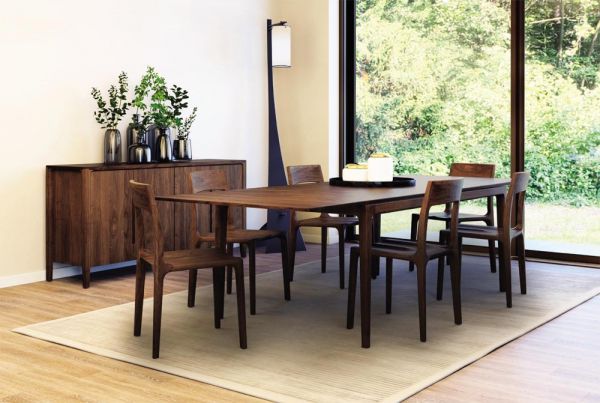Solid Wood vs Veneer: Pros and Cons to Consider When Selecting Furnishings
If you're looking to outfit your space with new furnishings, you may be overwhelmed by the number of available material options. These days, furniture is made not only from solid wood but veneer, composite wood, and other artificial wood finishes. As you shop, you'll want to be aware of the exact materials you're looking at, along with their potential advantages and drawbacks.
Many types of furniture are made either from solid wood or some kind of wood veneer. While they may look similar, wood and veneer are very different in terms of their weight, durability, and longevity. By having a better understanding of the inherent differences between the two, as well as their pros and cons, you can make a better-informed furniture purchase.
What is Solid Wood Furniture?
Solid wood furniture refers specifically to a piece made entirely out of natural wood (with the exception of upholstery, hardware, or other accents). Solid wood furniture can be made from any type of natural wood, including soft and hardwood. Some examples of the most common types of wood used in furniture making include:
- Oak
- Maple
- Walnut
- Mahogany

Shown above: Avant Cocktail table built with a solid steel base and solid wood top
Hardwoods, such as oak and cherry, are denser and thus more durable than softer woods. However, softwoods tend to be lighter and can certainly hold up to the test of time with proper care.
What is Veneer Furniture?
On the other hand, veneer furniture is designed to mimic natural wood's appearance. It is actually made up of a thin layer of natural wood attached to another material, such as particleboard, fiberboard, or MDF (medium density fiberboard) plywood. Typically, veneer in furniture is attached using glue to achieve the appearance of an all-wood design. Because the thin outer layer of veneer furnishing is made of natural wood, you can still enjoy the look and feel of a solid wood piece—often at a significantly lower price than that of an all-wood product, without sacrificing quality or aesthetics.
 Shown above: Media Cabinet with veneered walnut canaletto or oak stained wenge
Shown above: Media Cabinet with veneered walnut canaletto or oak stained wenge
Solid Wood vs. Veneer: Pros and Cons
Both solid wood and veneer furniture offer some inherent benefits and potential drawbacks. Both options are quite durable and can elevate the look of your space. Whether you're shopping for a dining room table, a dresser, or anything in between, you can likely find wood and veneer options that suit your design tastes.
However, solid wood is the better choice from a long-term durability standpoint. This is especially true if you opt for a piece of hardwood furniture which can last for generations with the proper care. Veneer in furniture can be durable if properly cared for—but because it is made up of a thin layer of real wood, the fiberboard underneath can be susceptible to damage, rot, and warping. However, choosing a high-quality veneer, like MDF, helps prevent warping. Domaine only uses high-end materials for luxury veneer pieces.
On the other hand, veneer tends to be more sustainable than solid wood. This is because only the piece's outer layer is comprised of real wood. This helps to conserve natural resources when compared to a solid wood piece.
From a cost standpoint, veneer also tends to be less expensive than solid wood in furniture. This is because the majority of a veneer piece is made up of cost-effective fiberboard or medium-density fiberboard (MDF).
Shoppers may find it easier to match the exact color, grain pattern, and style they’re searching for because the thin layer of real wood in veneer furniture allows for more options. For example, a skilled furniture maker or artisan will take advantage of the different grain patterns found in a single tree based on how it’s cut to deliver a one-of-a-kind piece.
Other unique geometries emerge when green patterns are matched and applied to a substrate. One of our hand-picked brands, Julian Chichester, strives to bring out these visually interesting patterns. Take the Fonda Desk, with it’s rounded design and African walnut top, you’re sure to draw eyes.
Finally, if you ever need to move your furniture, a wood veneer will be much lighter and, thus, easier to relocate. Solid wood furniture pieces are beautiful but can be a challenge to move—especially if you're dealing with a larger hardwood piece.
Whether you choose solid wood or veneer for your next furniture purchase, proper care is a must. Regular dusting and spot-cleaning will keep your furniture looking new for years. Likewise, be sure to follow all care instructions the furniture manufacturer provides. For solid wood pieces, a non-silicon-based furniture polish may be recommended.
How to Tell the Difference Between Solid Wood and Veneer
It can be challenging to distinguish between solid wood and wood veneer. If you visit a showroom, you can try lifting or testing the weight of a piece. Solid wood pieces will generally be more difficult to lift and move due to their heavier weight. If a large furniture piece is easier to lift and maneuver, it is likely made from a veneer.
Another way to mark the differences between solid wood and veneer is by examining any differences in the grain on the piece. Grains that look similar or furnishings that have symmetrical sides are more likely to be veneer. If you like a symmetrical look, a veneer may be the furniture for you.
A solid wood piece is less likely to have a repeating grain pattern, which is something to keep your eye out for if you prefer a more varied look in your furniture. Whether you like the symmetry offered from a veneer or feel a natural grain would fit better within your spaces, there will still be a lot of variety depending on the type of wood used in the furnishing.
When you shop at Domaine Furnishings, we are very transparent about the materials used in each piece. When you view a product online, simply check the "product details" for more information on the exact materials used in the construction.
Which is Right For Your Space?
Both solid wood and veneer furniture have their merits—one isn't inherently better than the other. Ultimately, it boils down to what's most important to you in your new furniture piece.
If you're looking for something that will offer unrivalled durability and beauty, solid wood furniture is probably your best bet. On the other hand, if you're more concerned about sustainability, it may not be a bad idea to explore your veneer options. The same goes if you have plans to move in the near future and want to select furnishings that will be easy to take with you.

While veneer can offer some cost savings, these pieces are still an investment when you’re looking for quality and craftsmanship. Prices will vary depending on the type of wood you like, the artisan, and what customizations you choose. This means the price tag will vary, much like it would with solid wood furnishings. Having your budget in place before you start shopping will give you the freedom to choose the solid wood or veneer that completes your vision the best, without sacrificing quality.
Discover Unrivaled Quality at Domaine Furnishings
No matter what type of furniture you have in mind, you can find eye-catching, quality selections at Domaine Furnishings. From dining room sets and desks to coffee tables, nightstands, and everything in between—we have something to suit your unique tastes.
Explore our world-class selection of furniture today, and be sure to reach out to our knowledgeable team with any questions you may have. We also offer personalized interior design services to help you take your space to the next level, so get in touch to schedule your consultation.>
